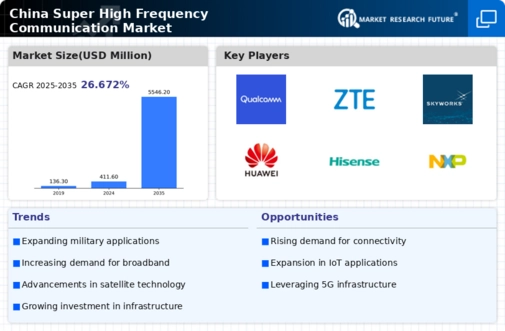Growing Military Investments
The super high-frequency-communication market in China is experiencing a surge in military investments, driven by the need for advanced communication systems. The Chinese government has allocated substantial budgets, reportedly exceeding $200 billion, to enhance military capabilities, including secure and efficient communication networks. This focus on military modernization is likely to propel the demand for super high-frequency communication technologies, as they offer superior data transmission rates and reliability. Furthermore, the strategic importance of secure communication in defense operations cannot be overstated, as it ensures operational effectiveness and national security. As a result, the military sector is anticipated to be a significant contributor to the growth of the super high-frequency-communication market, fostering innovation and technological advancements in this domain.
Increased Focus on Cybersecurity
The growing emphasis on cybersecurity in China is driving demand for secure communication solutions, particularly in the super high-frequency-communication market. As cyber threats become more sophisticated, organizations are prioritizing secure communication channels to protect sensitive information. The cybersecurity market in China is projected to grow at a CAGR of 20% over the next five years, indicating a strong demand for secure communication technologies. Super high-frequency communication systems, known for their robust encryption capabilities, are likely to play a vital role in addressing these security concerns. This heightened focus on cybersecurity is expected to propel the super high-frequency-communication market, as businesses and government entities seek reliable solutions to safeguard their communications.
Focus on Research and Development
China's emphasis on research and development (R&D) in communication technologies is a crucial driver for the super high-frequency-communication market. The government has initiated various programs aimed at fostering innovation, with R&D spending projected to reach 2.5% of GDP by 2026. This commitment to advancing communication technologies is likely to result in breakthroughs that enhance the capabilities of super high-frequency communication systems. As companies invest in R&D, the market may witness the introduction of cutting-edge solutions that improve efficiency, security, and reliability. This focus on innovation not only strengthens the competitive landscape but also positions the super high-frequency-communication market for sustained growth in the coming years.
Rising Demand for IoT Applications
The proliferation of Internet of Things (IoT) applications in China is significantly influencing the super high-frequency-communication market. As industries increasingly adopt IoT technologies, the need for efficient and high-speed communication systems becomes paramount. The market for IoT in China is expected to reach $300 billion by 2026, indicating a robust growth trajectory. Super high-frequency communication technologies are well-suited to support the vast data transmission requirements of IoT devices, enabling real-time communication and data processing. This trend suggests that the super high-frequency-communication market will likely see increased investments and innovations to cater to the evolving demands of IoT applications, thereby enhancing overall market growth.
Expansion of Telecommunications Infrastructure
China's rapid expansion of telecommunications infrastructure is a pivotal driver for the super high-frequency-communication market. With the government investing heavily in 5G networks and beyond, the demand for high-frequency communication systems is expected to rise. Reports indicate that the telecommunications sector is projected to grow at a CAGR of 15% over the next five years, creating a robust environment for super high-frequency communication technologies. This expansion not only enhances connectivity but also facilitates the integration of advanced communication solutions across various sectors, including healthcare, transportation, and smart cities. Consequently, the super high-frequency-communication market is likely to benefit from this infrastructure development, as it aligns with the increasing need for high-speed, reliable communication solutions.

















Leave a Comment